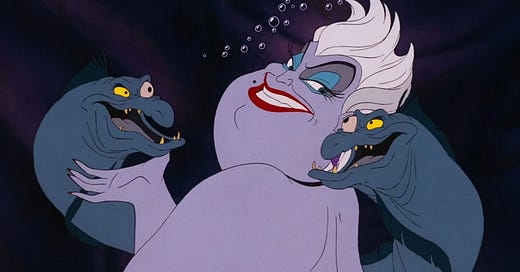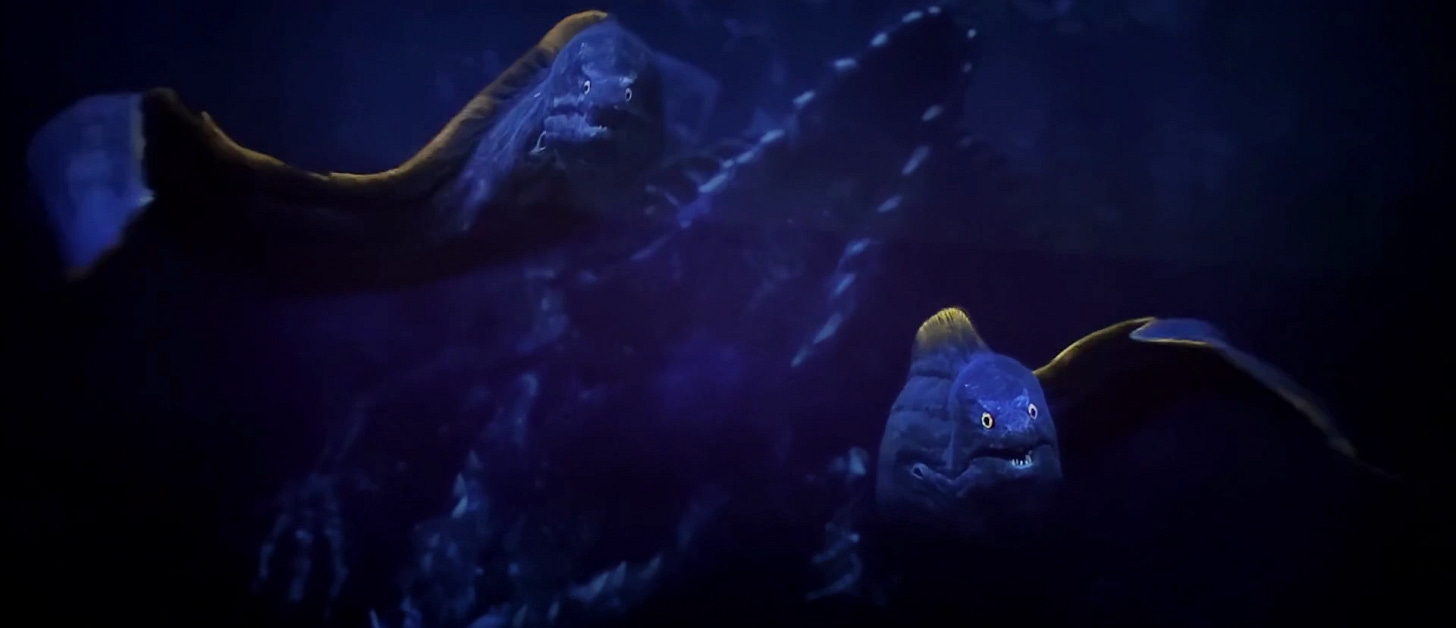Disney’s live action remakes of their animated classics have no shortage of problems to bemoan, but what do I choose to complain about? The eels in The Little Mermaid.
Flotsam and Jetsam are Ursula’s sinuous henchmen and are a prime example of a hollow depiction of evil twins. Their appearances, their speech patterns, and the way they twine is all crafted to unsettle and otherize. The eels would be indistinguishable if not for their mirrored heterochromia – Flotsam is the one with the left yellow eye and Jetsam is the one with the right yellow eye. The sole purpose of their existence is to carry out Ursula’s bidding and be her spies. They have no notable character, otherwise, except perhaps that they are some of the more wily of Disney’s villain sidekicks, having successfully pulled off every task that Ursula gave them to thwart Ariel.
In the original animated movie, the most significant of these tasks is convincing Ariel to visit Ursula, ultimately resulting in her legs-for-voice deal. This sales pitch is the longest speaking part that Flotsam and Jetsam have and, arguably, it’s one monologue split between them. The eels share a common objective and they play off one another to achieve their manipulation, alternating who is speaking to draw out the other’s thoughts. They only talk in sync during the most crucial part of the persuasion. It’s incredibly idealistic of how twins’ speak and diminishes the eels’ individualism.
But, is that better than them not speaking at all? In the live action version, Flotsam and Jetsam are non-speaking characters. In the persuasion scene described above, they instead summon a bubble portal that Ursula speaks to Ariel through and somehow what she says convinces Ariel to visit her.1 It reduces their role in the story to be even less important and dehumanizes2 them.
Additionally, Flotsam and Jetsam are electric eels in this version and are essentially weaponized by Ursula to harmfully constrain her opponents. This includes electrifying King Triton to death.3 Perhaps removing their voice lines was to account for their more brutal natures since having talking eels during those scenes would be even more deeply unsettling. Whatever the case, there was a decision to make this version more violent and, in doing so, depicts a set of twin beings as senseless monsters.
This particularly impacts the climax of the film when Ursula’s wayward strike of magic vaporizes Flotsam and Jetsam. This also occurs in the original version, but the lack of humanization and the little relationship established between them and Ursula in the live action makes their deaths even less sympathetic. Despite that, their deaths still drive Ursula to super-size herself for the final battle, but it comes across more as outrage at being outwitted rather than revenge for Flotsam and Jestam’s loss.
I found these changes to Flotsam and Jetsam very disappointing, especially in a film that is meant to be a regurgitation of the original. It made an already poor caricature of twins into an even worse one. I found a compilation of their scenes from the original on Youtube and Flotsam and Jetsam’s total screen time amounts to around 2 minutes and 39 seconds. I’m sure it’s far less than that in the live action version. They’re such inconsequential, minor characters, but they are still worth discussing when you consider how wide of an audience these movies reach. They perpetuate and teach the image of the evil twin archetype. Instead of addressing that and adding complexity to their twinship, the live action version makes them even more devoid of character.
I honestly wish that Flotsam and Jetsam had just been cut from the movie entirely if there was never any intention to treat their characters with respect as twins.
I would trust the talking eels over a strange woman in a bubble! It’s like picking the door-to-door salesmen over the spam call.
Defishizes? You know what I mean.
Don’t worry. He comes back.







